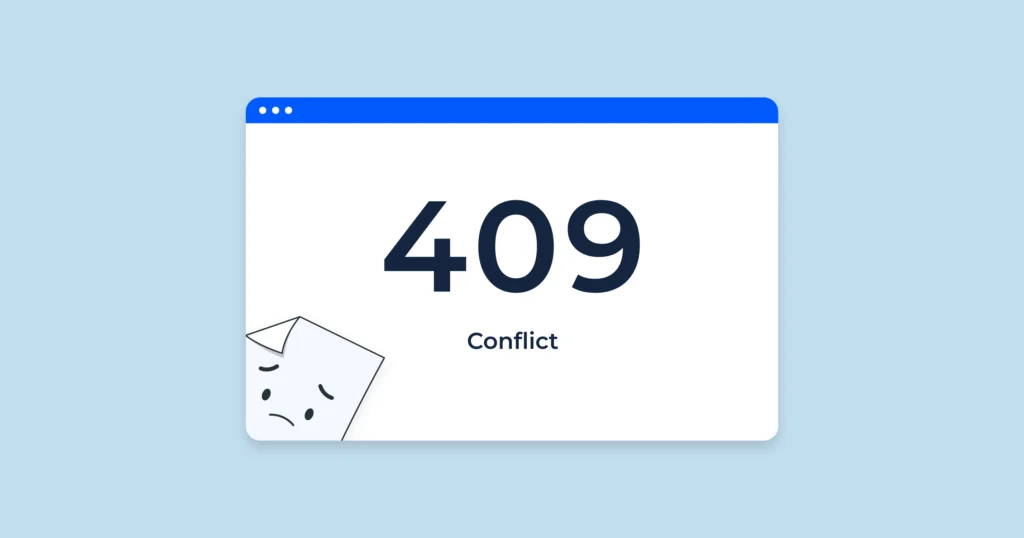
409 Status Code – Meaning, Causes & How to Fix It
When building modern websites or running online platforms, errors are inevitable. One such error that can confuse developers and site owners alike is the 409 Status Code, also known as a “Conflict” error.
If you’re trying to enhance your site’s performance and avoid such issues, working closely with the right Digital Marketing strategy or even collaborating with SEO Consultant can be key to optimizing for both users and search engines.
We will walk you through what a 409 Conflict error is, why it occurs, and actionable ways to fix and prevent it.
What is a 409 Status Code?
The 409 Conflict status code is part of the HTTP/1.1 standard. It signifies that the request could not be processed because of a conflict in the current state of the resource.
This commonly arises with PUT or POST requests where the server is expected to create or update a resource, but a logical conflict prevents it from doing so.
For example, if two users try to edit the same blog post at the same time, the server may respond with a 409 error to prevent data inconsistency.
Common Causes of a 409 Conflict Error
Several scenarios can lead to a 409 error:
Concurrent Updates
When multiple users try to modify the same resource simultaneously, creating a versioning conflict.
Duplicate Entries
When a new resource creation attempt conflicts with an existing one (e.g., username already taken).
File Upload Conflicts
When a user attempts to upload a file that conflicts with one already on the server.
Database Constraint Violations
Violations such as trying to insert a row with a duplicate key in a table.
Application Logic Limitations
When application rules prevent a request from being processed due to a predefined restriction.
How to Fix a 409 Conflict Error
Here are the most effective ways to fix this error:
1. Examine Server Logs and Error Messages
Always start by reviewing the error logs and server responses. Most 409 responses contain error details that can pinpoint the issue.
2. Validate Request Data
Ensure the request you’re sending is valid and not causing a conflict. Double-check if the resource already exists or has changed.
3. Use Optimistic Locking
Optimistic locking allows users to proceed with edits unless someone else has updated the record in the meantime. In such cases, the system can notify the user to reload the latest version.
4. Handle Versioning Gracefully
When working with APIs or file systems, version control helps avoid conflicts. Each request should include version metadata to detect changes.
5. Educate End Users
Sometimes, users can trigger 409 errors unknowingly. Inform them about what went wrong and how to fix it, instead of just showing a raw error.
Importance of Fixing 409 for SEO
Ignoring 409 errors can hurt your website’s performance in search rankings. Pages that throw frequent errors may be deindexed by search engines. Moreover, user frustration can increase bounce rates.
If you’re trying to keep your site clean, functional, and competitive, seeking assistance in Digital Marketing and technical SEO is advisable.
Mid-size and large enterprises, in particular, benefit from professional audits and fixes that prevent server-side conflicts.
Best Practices to Prevent 409 Errors
Locking and Concurrency Controls
Ensure that your system only allows one change at a time to critical data.
Conflict-Resolution UI
Implement interfaces that detect and allow users to resolve conflicts manually.
Versioning Systems
Always use timestamps, checksums, or versions to track resource states.
Unique Validations
Set up front-end and back-end validations to avoid submitting duplicate data.
Educate Developers and Users
Build awareness among your teams about why these errors occur and how to design for them.
Working with SEO and Digital Experts to Prevent Errors
Avoiding backend conflicts isn’t just a developer’s job anymore. Since such errors affect your site’s usability and ranking,
integrating technical audits into your SEO campaigns makes sense. Businesses that regularly consult with SEO Consultant services report higher site health and visibility.
Conclusion
Understanding the 409 Status Code is essential if you manage web content, APIs, or databases.
This error typically arises from conflicts during simultaneous updates or invalid requests that clash with existing resources.
While not as common as a 404 or 500 error, it can still affect site performance, SEO, and user trust.
By implementing best practices, using versioning, and seeking guidance from professionals in Digital Marketing, you can prevent 409 conflicts and ensure a seamless web experience.




